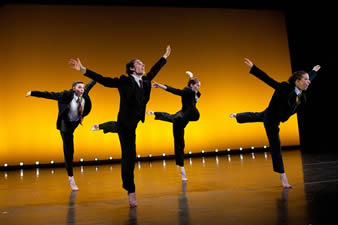Duke Chapel at four in the afternoon is ideal. The interior is bathed in the rich primary colors of the stained glass windows, the ambiance is all awe and reverence, and an atmosphere of serenity and security prevails. This was the setting for the Choral Society of Durham’s annual Christmas concert, this year featuring “Christmas Music for Choir & Brass.” Everything about this concert bespoke excellence, from the beautiful carillon serenade before and after to the outstanding program notes by Susan Dakin, from the ambience of Duke Chapel to the versatile accompaniment of Jane Lynch, from the fine brass and percussion ensemble to the beautiful solo voices from the choir and the masterful choice and arrangement of selections on the program. Of course, the stars of the event were the Choral Society of Durham and its conductor, Rodney Wynkoop.
When I sang in this illustrious group several years ago it was not uncommon to have singers drive from Goldsboro or Wilson or beyond to have the opportunity to sing under Wynkoop’s tutelage, and I am sure the same is true today. Rehearsals were filled with insights into the meaning of the musical score and the text, sometimes illustrated by the conductor dancing around the room to communicate the spirit of a given passage of music. After hours of serious and demanding work, you knew the heart and soul of the music and in many instances you performed beyond your individual capability because of the vision communicated by Wynkoop.
This year’s Christmas concert was the most nearly perfect choral recital I have ever heard. The only distractions were a couple of unbelievable audience improprieties that actually disrupted the performance. But putting that quickly aside, the performance itself was brilliant.
The program opened with two carols by Mack Wilburg, Associate Director of the Mormon Tabernacle Choir. The first, “Gloria tibi domine” (“A Little Child there is Ybore”), is an exuberant celebration of the birth of the Christ child set for full chorus, organ, brass and percussion, and it filled the Chapel with joy and energy. The second, “Lullee, lullai, lullo, lullabye” (“O, who will come and listen this night?”), is a lullaby — hushed, simple and beautiful. Two carols arranged by Robert Millett came next; the quiet, meditative “Coventry Carol” came first, followed by the exuberant “Wexford Carol.”
One of the most undervalued of 19th century composers is Anton Bruckner. He is often thought of as a symphonic Wagner, and he while he greatly admired the music of Wagner, he was much more than a mere imitator or disciple. His setting of “Ave Maria,” a relatively early work for seven part unaccompanied chorus, is a fervent prayer to the Virgin. When the chorus reached the climactic word “Jesus,” separating the two verses of the motet, the effect was like cracking open some inner locked vault, full of pain and sorrow, and releasing its contents all at once. The rest of the piece was like soothing, healing balm, and the cadential “Amen” ended the prayer with a perfect sense of peace.
Benjamin Britten came along about a hundred years after Bruckner, and had the same extraordinary talent for setting text to music in a manner that adds higher meanings to both. The Chamber Choir, a select group from the larger Chorus, sang “A Hymn to the Virgin” with delicious intensity.
When Morten Lauridsen wrote his setting of “O Magnum Mysterium,” the ancient poem meditating on the mysteries of the incarnation — the birth of Christ in a manger among animals — he must have been under the inspiration of the same star that illuminated that night, long ago. It is a composition of ethereal beauty, transcendent and moving, which seems to grow more intense with each hearing. Under Wynkoop’s direction, every phrase had purpose and direction, every word had life, and the overall effect was breathtaking.
Before intermission we heard three renaissance works for choir and brass – that wonderful ceremonial sound especially known at San Marco in Venice. First was Michael Praetorius’ familiar “In dulci jubilo,” then Samuel Scheidt’s “A child is born in Bethlehem,” sung by the Chamber Choir. That was followed by a 20th century meditation on the same carol by American composer Leo Nestor, in which the women of the chorus sang a wonderfully sustained plainsong line. The first half closed with the third of the renaissance works, Giovanni Gabrieli’s “Hodie Christus natus est.”
The second half of the concert opened with three carols: a sprightly revision of “Joy to the World” by Jackson Berkey, John Rutter’s warmly sentimental setting of “Silent Night,” and an excellent arrangement of “Angels we have heard on high” by Romanian-American composer Gabriel Dumitrescu. The attacks and releases, the shaping of phrases, and the life in the words of this selection were all superb, and this group truly sparkled.
Three renaissance pieces prepared the way for the closing and featured work Canite tuba: A Christmas Triptych, by Donald McCullough, which employs the same Latin texts. “Canite tuba” by Palestrina, “Verbum caro factum est” by Hans Leo Hassler, and “Surge illuminare” by William Byrd were each mystically beautiful in their own right. Dakin’s notes describe McCullough’s work, which was first performed under the composer’s direction at the Kennedy Center three years ago: “The first movement opens with a choral proclamation and trumpet fanfares, followed by a jagged, syncopated section on the text ‘erunt prava in directa’ (‘the crooked will become straight’), and closes with a dramatic plea for the Lord to come. The mystical atmosphere of ‘Verbum caro factum est’ is established by the hushed, sustained accompaniment and chant-like vocal lines that build to an ecstatic climax on the word ‘gloriam.’ The final movement’s proclamatory introduction gives way to a joyous, playful fugal section on the text ‘et gloria Domini super te orta est’ (‘and the glory of the Lord has risen upon you’). Alleluia, indeed!”
It was a brilliant and memorable concert. Highest praise and gratitude to all involved!











